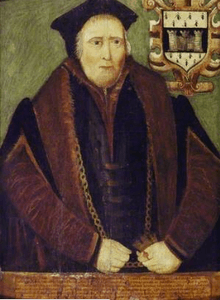Soulton Hall
Soulton Hall /ˈsʊltɒn/ is a country house in Shropshire, England, located two miles east of the town of Wem, on the B5065.
| Soulton Hall | |
|---|---|
Soulton Hall in Shropshire | |
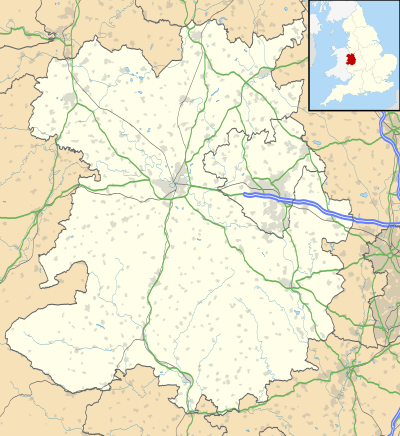 Location within Shropshire | |
| Former names | Suletune, Suleton, Soleton, Sulton, Sowton, Soughton,[1] |
| General information | |
| Architectural style | Tudor architecture |
| Location | near Wem, Shrewsbury, Shropshire |
| Country | England |
| Coordinates | 52.8678°N 2.679°W |
| Elevation | 125 m (410 ft) |
| Construction started | prior to 1017 for the manor, on the current site by the late 1300s, with the current brick exterior begun in 1556 |
| Technical details | |
| Material | Grinshill Sandstone and Tudor brick, incorporating medieval timber framing |
| Design and construction | |
| Architect | ? Walter Hancock |
| Website | |
| www | |
The Present Hall
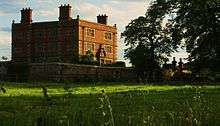
The manor of Soulton is pre-Norman in origin. What can be seen externally of the present hall is constructed of brick, fired from clay at the site in a field now known as "the Brickle", a corruption of "Brick Kiln", with Grinshill stone dressings.
The present exterior of the building was constructed in approximately 1668, but incorporates some hidden older structures. However in incorporates within the building traces of an older Tudor or medieval building of timber frame construction, which would have been of considerable extent for its time: four stories high, of three bays, and containing close stud work. Some of the timbers even within this structure were reused from a yet older building.
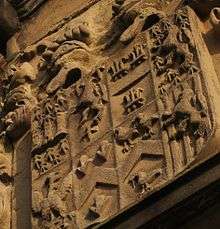
The hall of the 1550s which can be seen today was built by Sir Rowland Hill (MP), who was the first Protestant Lord Mayor of London in 1549, and, as Sheriff of London, was involved in the case which established Parliamentary Privilege. It has been speculated that this building was the work of Walter Hancock, who built the Old Market Hall in Shrewsbury. The manors of Hawkstone and Soulton were sold in 1556 by Thomas Lodge to Sir Rowland Hill and Thomas Leigh under long leases (until 1610) for quiet enjoyment by his brother Edward Lodge.[2]
Within the building are traces of an older Tudor or medieval building of timber frame construction, thought to date from the late 15th century.
Examples of simple pargeting on this earlier building can be seen within the building.
In 1668 a semi-circular pediment bearing the marital coat of arms of Thomas Hill, a descendant of Sir Rowland's and a friend of Samuel Pepys, was added above the front door. The blazon on those arms is given below.
There are said to be masonic influences in this semi-circular pediment, and the hall's cubic appearance may be an early re-interpretation of Vitruvian ideas.
To the east of the hall is a walled garden, accessed by steps from the terrace on the north, or by a small gate to the north.
At the front of the hall is a Pillared forecourt, again part of the 1550s design concept.
Associated Buildings and Features
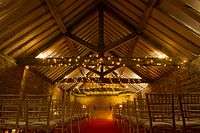

Within the grounds of the hall are thought to be the remains of extensive medieval gardens although it is possible that the obvious forms in the fields near the hall may be the remains of a deserted medieval village.
These are a Scheduled Ancient Monument.[3]
There are also some 18th-century farm buildings, of which a range of buildings now known as Soulton Court, which has a stone tablet dated 1783 relating to later work, incorporates a manorial moot hall of unknown date prior to the mid-1600s.
A dovecot once existed to the east of the garden wall, it had been dismantled by the end of the 1800s.
History of the Manor

Saxon and earlier
Within the manor is evidence Bronze Age habitation, and some signs of Neolithic activity.[4]
The name of the manor is Saxon and means either 'settlement with a plough' or 'settlement with reeds' or possibly 'settlement in/near a gully' .[5]
The manor of Soulton existed at the time of the Domesday Book (see: PASE Domesday) and is recorded as "Svltune".
The Domesday Book goes on to record the manor as being freely held by Brihtric, the brother of Eadric Streona, who was the Ealdorman of Mercia. Both Brihtric and Eadric were slain by King Cnut on Christmas Day, 1017.
Post Norman
The building on the present site was pre-dated by Saxon ane perhaps earlier structures. A Norman Adulterine castle was constructed approximately 300 meters to the north-east of the hall during the Anarchy in the early 1100s.[6]
The manor supported the clergy of the King's Chapel of St Micheal in Shrewsbury Castle. The manor house has probably always occupied the current site with this fortification only being used for military and not domestic purposes.
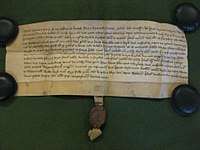
The location is marked by a mound which can still be seen. This site is located around the point at which the roadway crosses a narrow gap in some wet terrain which would likely have had a strategic reason for establishing a fortification in that location. This building is believed to have burnt down at some point in the late 14th century.
A grant of the manor in 1299 indicates that some of the ancient marker posts marking the boundary with Wales were part of the boundary of the manor.
Post 1556
The present hall, described above was built in 1556, remolding the surviving the earlier hall.
There is an 1801 Thomas Telford bridge on the B5065 known as Soulton Bridge.[7][8]
There are also the remains of a water mill active from at least the 1300s until the mid-to-late 1800s.
Modern Monolithic Monuments

Long Barrow
A modern long barrow, Soulton Long Barrow, is under construction on farmland north of Soulton Hall.
The site became operational in 2019.[9] The new monument was covered on an episode of BBC Countryfile being visited by Matt Baker and Ellie Harrison in April 2019.[10]
Standing Stones


Three megalithic limestone standing stones are located on the access route to the barrow. These were added to the approach route to the barrow in autumn 2017.[11] The stone for these monoliths, as with the barrow itself came from Churchfield Quarry, Oundle, near Peterborough. There is no deliberate alignment beyond way-marking for these standing stones. In 2020, a standing stone, with an alignment to the setting sun on the winter solstice, was added to the ritual landscape to acknowledged the suffering of the families impacted by the Coronavirus Pandemic.[12][13]
Farm
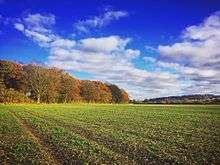
There is a farm at the manor, including Soulton Wood.
The farm practices no-till farming. This was covered in an episode of BBC Countryfile in April 2019 with Matt Baker.[18]
Research cooperation between Harper Adams University and Oxford University looking at the results of cultivation on Soil ecology, which used DNA sequencing of the soil biome has been hosted on the farm.[19]
The woodland is largely oak with some cherry and ash.
In total the woodland covers about 50 acres and it is designated ancient woodland.
Material from the wood was supplied for repair of the House of Commons after bomb damage in the Second World War.[20]
Archaeology
The manor includes various protected archaeology.
An official excavation with Dig Ventures took place in June 2019.[21][22]
Coat of arms
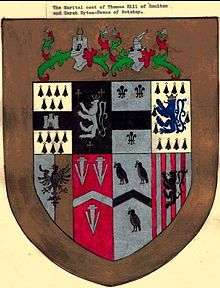
The blazen of the arms added above the front door in 1688 is as follows:[23]
- Hill of Court of Hill ermine, on a fesse sable a triple towered castle argent
- Hill of Longslow: Sable, a lion rampent argent, langued and armed, crowned or between three croffed fromee fitchee of the second;
- Evans of Watstay, Co Denbigh Argent, a fesse between three fleur-de-lys, sable;
- Eyton of Rhiwabon C Denbigh ermine, a lion rampant crowned or, langued and armed;
- Bird of Charleton, per pale or and argent, an eale displayed, beaked and armed;
- Hill of Buntinsdale; gules, a chevron between three pheons argent, points downwards;
- Lloyd, (Bishop of St Asaph, 1680) argent, a chevron between three crows sable, each holding in its beak an ermine spot;
- Grifith, Lord of Bromfield Play of eight argent and gules, a lion rampant sable;
Culture and Heritage

Soulton Hall is a Grade II* listed building, along with its walled gardens, pillared forecourt and carved stone work. Soulton Bridge, crossing Soulton Brook is a Grade I listed structure, built in 1801 by Thomas Telford.
It is now a hotel and farm. It is still owned by descendants of Sir Rowland Hill.
Some affinity both architectural, and by family connections has been attributed to Soulton with Rosewell (plantation) in Virginia.
An eighteenth century dance, the Soulton Jigg, is linked to the manor and published in John Walsh's 1740 "The Second Book of the Compleat Country Dancing-Master".[24]
There is periodic filming at the manor.[25]
Spelling
Before the modern spelling of 'Soulton', a wide variation in spelling can be observed:[26]
- Suletune (Domesday Book, 1086)
- Suleton' (Curia Regis Rolls 1200; Rotuli Hundredorum, 1255)
- Soleton (Assize Rolls, 1271-2; Feudal Aids 1284-5A)
- Sulton' (Assize Rolls 1271-2, 91-2)
- Sulton (Feudal Aids 1431, 1470, 84; Calendar of Close Rolls Preserved in the Public Record Office, 1703; Shropshire Parish Registers, 1809)
- Solton' (1334, The Shropshire Lay Subsidy Roll of 1 Edward III)
- Sowton (Saxton's Map of Shropshire, 1695 The County Maps from William Camden's Britannia 1695 by Robert Morden)
- Soughton; 1672, The Shropshire Hearth-Tax Roll of 1672)
- Soulton (1677, Shropshire Parish Register)
- Saulton (artifacts at the building, 1800s)
Present Use
The manor is now a hotel and venue.
Gallery
 Buttery Room in Soulton Hall
Buttery Room in Soulton Hall Carved Tudor Stone Work, possibly an interior feature now in the gardens
Carved Tudor Stone Work, possibly an interior feature now in the gardens Dining Room in Soulton Hall
Dining Room in Soulton Hall 1668 Marital coat of arms above front door
1668 Marital coat of arms above front door Wood paneling remaining in some rooms
Wood paneling remaining in some rooms
Sustainability
The hall and annex buildings are heated by 62kWp Ground source heat pump, and the home site has a 50kWp solar PV array. These were installed in the 24 months from December 2011.
References and further reading
- An excursion from Sidmouth to Chester in the summer of 1803 (1803) by Edmund Butcher. Whittingham.
- Antiquities of Shropshire, Vol. 10 (1860) by Robert William Eyton. J.R. Smith,.
- The Castles & Old Mansions of Shropshire (1868) by Frances Stackhouse Acton. Leake and Evans.
- Memorials of Old Shropshire (1906) by Thomas Auden. Bemrose & Sons.
- Transactions of the Shropshire Archaeological and Natural History Society, Volume 40 (1919). Shropshire Archaeological and Natural History Society.
- Proceedings of the American Philosophical Society Held at Philadelphia (1939). American Philosophical Society. 1939
- Burke's Guide to Country Houses: Reid, P. Herefordshire, Shropshire, Warwickshire, Worcestershire (1978) by Mark Bence-Jones, and Peter Reid. Burke's Peerage.
- The Tudor and Stuart Legacy, 1530-1730 (1989) by Lawrence Garner. Swan Hill.
- The World of the Country House in Seventeenth-century England (1999) by John Trevor Cliffe. Yale University Press.
- Hills of Hawkstone (2005) by Joanna Hill. Phillimore & Co Ltd.
- Shropshire (Pevsner Architectural Guides: Buildings of England) (2006) by John Newman. Yale University Press.
- Design and Plan in the Country House: From Castle Donjons to Palladian Boxes (2008) by Andor Gomme, Austin Harvey Gomme, and Alison Maguire. Yale University Press.
References
- http://placenames.org.uk/browse/mads/epns-deep-82-b-subparish-000108
- The National Archives, Discovery Catalogue piece description 'Bargain and sale (1556)', 215/31 (Shropshire Archives).
- Historic England. "Soulton moated site and formal garden remains (1017236)". National Heritage List for England. Retrieved 11 February 2017.
- "Soulton Hall on Twitter". Twitter. Retrieved 11 February 2017.
- English Place-Name Society. The University Press. 1 January 1990.
- Historic England. "Soulton moated site and formal garden remains (1017236)". National Heritage List for England. Retrieved 11 February 2017.
- Historic England. "Details from listed building database (1237047)". National Heritage List for England. Retrieved 10 February 2017.
- http://www.britishlistedbuildings.co.uk/en-427941-soulton-bridge-wem-rural-
- Wainwright, Oliver (18 March 2019). "Tomb with a view: why burial mounds are a better way to go". The Guardian. ISSN 0261-3077. Retrieved 3 June 2019.
- "BBC One - Countryfile, Shropshire". BBC. Retrieved 3 June 2019.
- Pugh, James. "Three limestone monoliths mark a path to Shropshire's first long barrow in 5,000 years". www.shropshirestar.com. Retrieved 27 April 2018.
- "Standing stone to be raised at Soulton Long Barrow for Covid-19 victims". Whitchurch Herald. Retrieved 1 August 2020.
- Bentley, Charlotte. "Shropshire standing stone memorial built for Covid-19 victims and their families". www.shropshirestar.com. Retrieved 8 August 2020.
- Bentley, Charlotte. "Shrop-henge?: Plan for Bronze age-inspired monument in Shropshire". www.shropshirestar.com. Retrieved 13 March 2020.
- www.bbc.co.uk https://www.bbc.co.uk/programmes/b006mj57. Retrieved 15 August 2020. Missing or empty
|title=(help) - editor, Chris Wiegand Stage (6 August 2020). "From an earth stage to a willow Globe: theatre goes al fresco in the UK". The Guardian. ISSN 0261-3077. Retrieved 8 August 2020.CS1 maint: extra text: authors list (link)
- "Jeremy Vine - Planning Permission and Pantomimes - BBC Sounds". www.bbc.co.uk. Retrieved 8 August 2020.
- "BBC One - Countryfile, Shropshire". BBC. Retrieved 3 June 2019.
- http://www.soultonhall.co.uk/news/27/no-till-biome-experiment-.htm
- http://www.soultonhall.co.uk/page/150/soulton-wood.htm
- "Dirty Weekend: Dig into Shropshire's past at Soulton Hall". DigVentures. Retrieved 3 June 2019.
- "Soulton Hall archaeological dig hints at fascinating history". Whitchurch Herald. Retrieved 10 July 2019.
- http://www.soultonhall.co.uk/page/120/coat-of-arms.htm
- "Soulton Jigg - The Traditional Tune Archive". www.tunearch.org. Retrieved 11 February 2017.
- http://www.soultonhall.co.uk/page/70/film-location.htm
- http://placenames.org.uk/browse/mads/epns-deep-82-b-subparish-000108

